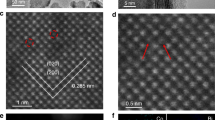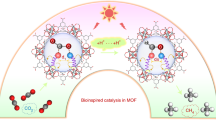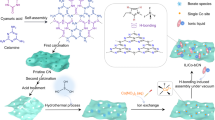Abstract
Due to the large number of possible products and their similar reduction potentials, a significant challenge in CO2 photoreduction is achieving selectivity to a single product while maintaining high conversion efficiency. Controlling the reaction intermediates that form on the catalyst surface through careful catalyst design is therefore crucial. Here, we prepare atomically thin layers of sulfur-deficient CuIn5S8 that contain charge-enriched Cu–In dual sites, which are highly selective towards photocatalytic production of CH4 from CO2. We propose that the formation of a highly stable Cu–C–O–In intermediate at the Cu–In dual sites is the key feature determining selectivity. We suggest that this configuration not only lowers the overall activation energy barrier, but also converts the endoergic protonation step to an exoergic reaction process, thus changing the reaction pathway to form CH4 instead of CO. As a result, the CuIn5S8 single-unit-cell layers achieve near 100% selectivity for visible-light-driven CO2 reduction to CH4 over CO, with a rate of 8.7 μmol g−1 h−1.
This is a preview of subscription content, access via your institution
Access options
Access Nature and 54 other Nature Portfolio journals
Get Nature+, our best-value online-access subscription
$29.99 / 30 days
cancel any time
Subscribe to this journal
Receive 12 digital issues and online access to articles
$119.00 per year
only $9.92 per issue
Buy this article
- Purchase on Springer Link
- Instant access to full article PDF
Prices may be subject to local taxes which are calculated during checkout





Similar content being viewed by others
Data availability
The data that support the plots within this paper and other findings of this study are available from the corresponding author upon reasonable request.
References
Aresta, M., Dibenedetto, A. & Angelini, A. Catalysis for the valorization of exhaust carbon: from CO2 to chemicals, materials and fuels. Technological use of CO2. Chem. Rev. 114, 1709–1742 (2013).
Ma, S. & Kenis, P. J. Electrochemical conversion of CO2 to useful chemicals: current status, remaining challenges and future opportunities. Curr. Opin. Chem. Eng. 2, 191–199 (2013).
Zhou, H. et al. Artificial inorganic leafs for efficient photochemical hydrogen production inspired by natural photosynthesis. Adv. Mater. 22, 951–956 (2010).
Corma, A. & Garcia, H. Photocatalytic reduction of CO2 for fuel production: possibilities and challenges. J. Catal. 308, 168–175 (2013).
Varghese, O. K., Paulose, M., LaTempa, T. J. & Grimes, C. A. High-rate solar photocatalytic conversion of CO2 and water vapor to hydrocarbon fuels. Nano Lett. 9, 731–737 (2009).
Kim, W., Seok, T. & Choi, W. Nafion layer-enhanced photosynthetic conversion of CO2 into hydrocarbons on TiO2 nanoparticles. Energy Environ. Sci. 5, 6066–6070 (2012).
Li, K. et al. A critical review of CO2 photoconversion: catalysts and reactors. Catal. Today 224, 3–12 (2014).
Zhu, S. et al. Photocatalytic reduction of CO2 with H2O to CH4 over ultrathin SnNb2O6 2D nanosheets under visible light irradiation. Green Chem. 18, 1355–1363 (2016).
Zhang, Y. et al. Bi2MoO6 nanostrip networks for enhanced visible-light photocatalytic reduction of CO2 to CH4. ChemPhysChem 18, 3240–3244 (2017).
Liu, Q. et al. Single-crystalline, ultrathin ZnGa2O4 nanosheet scaffolds to promote photocatalytic activity in CO2 reduction into methane. ACS Appl. Mater. Interfaces 6, 2356–2361 (2014).
AlOtaibi, B. et al. Wafer-level artificial photosynthesis for CO2 reduction into CH4 and CO using GaN nanowires. ACS Catal. 5, 5342–5348 (2015).
Jiang, Z. et al. Nature-based catalyst for visible-light-driven photocatalytic CO2 reduction. Energy Environ. Sci. 11, 2382–2389 (2018).
Sorcar, S., Hwang, Y., Grimes, C. A. & In, S. I. Highly enhanced and stable activity of defect-induced titania nanoparticles for solar light-driven CO2 reduction into CH4. Mater. Today 20, 507–515 (2017).
Tu, W., Zhou, Y. & Zou, Z. Photocatalytic conversion of CO2 into renewable hydrocarbon fuels: state-of-the-art accomplishment, challenges and prospects. Adv. Mater. 26, 4607–4626 (2014).
Rao, H., Schmidt, L. C., Bonin, J. & Robert, M. Visible-light-driven methane formation from CO2 with a molecular iron catalyst. Nature 548, 74–77 (2017).
Wu, J. et al. Efficient visible‐light‐driven CO2 reduction mediated by defect‐engineered BiOBr atomic layers. Angew. Chem. Int. Ed. 130, 8855–8859 (2018).
Jiao, X. et al. Defect-mediated electron-hole separation in one-unit-cell ZnIn2S4 layers for boosted solar-driven CO2 reduction. J. Am. Chem. Soc. 139, 7586–7594 (2017).
Roy, S. C., Varghese, O. K., Paulose, M. & Grimes, C. A. Toward solar fuels: photocatalytic conversion of carbon dioxide to hydrocarbons. ACS Nano 4, 1259–1278 (2010).
Kim, D., Resasco, J., Yu, Y., Asiri, A. M. & Yang, P. Synergistic geometric and electronic effects for electrochemical reduction of carbon dioxide using gold–copper bimetallic nanoparticles. Nat. Commun. 5, 4948 (2014).
Ghuman, K. K. et al. Photoexcited surface frustrated Lewis pairs for heterogeneous photocatalytic CO2 reduction. J. Am. Chem. Soc. 138, 1206–1214 (2016).
Wang, S., Guan, B. Y., Lu, Y. & Lou, X. W. D. Formation of hierarchical In2S3–CdIn2S4 heterostructured nanotubes for efficient and stable visible light CO2 reduction. J. Am. Chem. Soc. 139, 17305–17308 (2017).
Sorcar, S. et al. High-rate solar-light photoconversion of CO2 to fuel: controllable transformation from C1 to C2 products. Energy Environ. Sci. 11, 3183–3193 (2018).
Bae, K. L., Kim, J., Lim, C. K., Nam, K. M. & Song, H. Colloidal zinc oxide-copper(i) oxide nanocatalysts for selective aqueous photocatalytic carbon dioxide conversion into methane. Nat. Commun. 8, 1156 (2017).
Sun, Y., Gao, S. & Xie, Y. Atomically-thick two-dimensional crystals: electronic structure regulation and energy device construction. Chem. Soc. Rev. 43, 530–546 (2014).
Sun, Y. et al. Pits confined in ultrathin cerium(iv) oxide for studying catalytic centers in carbon monoxide oxidation. Nat. Commun. 4, 2899 (2013).
Gannouni, M., Assaker, I. B. & Chtourou, R. Photoelectrochemical cell based on n-CuIn5S8 film as photoanodes for photocatalytic water splitting. Int. J. Hydrog. Energy 40, 7252–7259 (2015).
Hu, S., Chen, X., Li, Q., Zhao, Y. & Mao, W. Effect of sulfur vacancies on the nitrogen photofixation performance of ternary metal sulfide photocatalysts. Catal. Sci. Technol. 6, 5884–5890 (2016).
Jeong, H. Y. et al. Heterogeneous defect domains in single-crystalline hexagonal WS2. Adv. Mater. 29, 1605043 (2017).
Jiao, X. et al. Partially oxidized SnS2 atomic layers achieving efficient visible-light-driven CO2 reduction. J. Am. Chem. Soc. 139, 18044–18051 (2017).
Zhang, N. et al. Oxide defect engineering enables to couple solar energy into oxygen activation. J. Am. Chem. Soc. 138, 8928–8935 (2016).
Yuan, Q. et al. Noble-metal-free janus-like structures by cation exchange for Z-scheme photocatalytic water splitting under broadband light irradiation. Angew. Chem. Int. Ed. 129, 4270–4274 (2017).
Hwang, J., Li, P., Smith, M. D. & Shimizu, K. D. Distance-dependent attractive and repulsive interactions of bulky alkyl groups. Angew. Chem. Int. Ed. 128, 8218–8221 (2016).
Wang, T. et al. Photoreduction of CO2 over the well-crystallized ordered mesoporous TiO2 with the confined space effect. Nano Energy 9, 50–60 (2014).
Ulagappan, N. & Frei, H. Mechanistic study of CO2 photoreduction in Ti silicalite molecular sieve by FT-IR spectroscopy. J. Phys. Chem. A 104, 7834–7839 (2000).
Wu, J. C. & Huang, C. W. In situ DRIFTS study of photocatalytic CO2 reduction under UV irradiation. Front. Chem. Eng. China 4, 120–126 (2010).
Liu, Y., Chen, S., Quan, X. & Yu, H. Efficient electrochemical reduction of carbon dioxide to acetate on nitrogen-doped nanodiamond. J. Am. Chem. Soc. 137, 11631–11636 (2015).
Yates, J. & Cavanagh, R. Search for chemisorbed HCO: the interaction of formaldehyde, glyoxal and atomic hydrogen + CO with Rh. J. Catal. 74, 97–109 (1982).
Ewing, G. E., Thompson, W. E. & Pimentel, G. C. Infrared detection of the formyl radical HCO. J. Chem. Phys. 32, 927–932 (1960).
Liu, L. & Li, Y. Understanding the reaction mechanism of photocatalytic reduction of CO2 with H2O on TiO2-based photocatalysts: a review. Aerosol Air Qual. Res. 14, 453–469 (2014).
Vigier, F., Coutanceau, C., Hahn, F., Belgsir, E. & Lamy, C. On the mechanism of ethanol electro-oxidation on Pt and PtSn catalysts: electrochemical and in situ IR reflectance spectroscopy studies. J. Electroanal. Chem. 563, 81–89 (2004).
Wang, Q., Hisatomi, T., Ma, S. S. K., Li, Y. & Domen, K. Core/shell structured La- and Rh-codoped SrTiO3 as a hydrogen evolution photocatalyst in Z-scheme overall water splitting under visible light irradiation. Chem. Mater. 26, 4144–4150 (2014).
Zhang, H. et al. Bacteria photosensitized by intracellular gold nanoclusters for solar fuel production. Nat. Nanotechnol. 13, 900–905 (2018).
Kresse, G. & Furthmüller, J. Efficiency of ab-initio total energy calculations for metals and semiconductors using a plane-wave basis set. Comp. Mater. Sci. 6, 15–50 (1996).
Surendranath, Y., Kanan, M. W. & Nocera, D. G. Mechanistic studies of the oxygen evolution reaction by a cobalt-phosphate catalyst at neutral pH. J. Am. Chem. Soc. 132, 16501–16509 (2010).
Perdew, J. P., Burke, K. & Ernzerhof, M. Generalized gradient approximation made simple. Phys. Rev. Lett. 77, 3865 (1996).
Hammer, B., Hansen, L. B. & Nørskov, J. K. Improved adsorption energetics within density-functional theory using revised Perdew–Burke–Ernzerhof functionals. Phys. Rev. B 59, 7413 (1999).
Shek, C., Lai, J. & Lin, G. Investigation of interface defects in nanocrystalline SnO2 by positron annihilation. J. Phys. Chem. Solids 60, 189–193 (1999).
Acknowledgements
This work was financially supported by the National Key R&D Program of China (2017YFA0207301 and 2017YFA0303500), the National Natural Science Foundation of China (U1632147, 21890754, U1532265 and 11621063), the Youth Innovation Promotion Association of CAS (CX2340000100), the Key Research Program of Frontier Sciences of CAS (QYZDY-SSW-SLH011), the Fundamental Research Funds for the Central Universities (WK2340000063 and WK2340000073), the Innovative Program of Development Foundation of Hefei Center for Physical Science and Technology (2017FXCX006) and the Fok Ying-Tong Education Foundation (161012). The Supercomputing USTC and National Supercomputing Center in Shenzhen are acknowledged for computational support.
Author information
Authors and Affiliations
Contributions
Y.X., Y.Sun and X.L. conceived the idea and co-wrote the paper. Y.Sun, X.L., Y.Shao, J.X., Y.P., H.J. and J.Z. carried out the sample synthesis, characterization and CO2 reduction measurement. Y.Sun, X.L., J.W. and X.X. discussed the catalytic process. All authors contributed to the overall scientific interpretation and edited the manuscript.
Corresponding authors
Ethics declarations
Competing interests
The authors declare no competing interests.
Additional information
Publisher’s note: Springer Nature remains neutral with regard to jurisdictional claims in published maps and institutional affiliations.
Supplementary information
Supplementary Information
Supplementary Figs. 1–24, Supplementary Tables 1–4, Supplementary refs.
Rights and permissions
About this article
Cite this article
Li, X., Sun, Y., Xu, J. et al. Selective visible-light-driven photocatalytic CO2 reduction to CH4 mediated by atomically thin CuIn5S8 layers. Nat Energy 4, 690–699 (2019). https://doi.org/10.1038/s41560-019-0431-1
Received:
Accepted:
Published:
Issue Date:
DOI: https://doi.org/10.1038/s41560-019-0431-1
This article is cited by
-
Elucidating protonation pathways in CO2 photoreduction using the kinetic isotope effect
Nature Communications (2024)
-
Bismuth clusters pinned on TiO2 porous nanowires boosting charge transfer for CO2 photoreduction to CH4
Nano Research (2024)
-
MOF-derived Co3O4/ZrO2 mesoporous octahedrons with optimized charge transfer and intermediate conversion for efficient CO2 photoreduction
Science China Materials (2024)
-
Manipulating the electronic structure of platinum via alloying with ruthenium to boost photocatalytic selective hydrogenation with water as a proton source
Science China Materials (2024)
-
Improving CO2 photoconversion with ionic liquid and Co single atoms
Nature Communications (2023)



